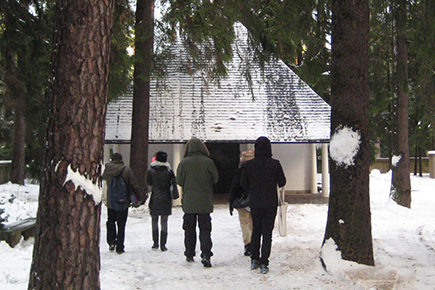Persuasive, Humanitarian & Environmental Experience (MA) Konstfack

The 1st year colloquium provided a foundation of concepts and skills for students in the MA/MFA Experience Design program at Konstfack University of Arts, Crafts and Design. It was compulsory for first-years and co-taught by faculty members of the Experience Design program. While there was some variation, generally it was divided into divided into 5 modules: individual thesis work; a qualifying examination; the Experience Design Lab (7.5 credits); and Humanitarian, Persuasive and Environmental Experience (4.5 credits each).
Level Masters (MA/MFA) compulsory for Experience Design program
Credits 4.5-24
Dates 2007-2010
Number of students 9-12
My role
– 2009-2010: I was responsible for the Humanitarian and Environmental Experience modules with Martin Avila
– 2008-2009: I was responsible for the Environmental Experience module
– 2007-2008: I taught in the Experience Design Lab with Jenny Althoff and Martin Avila and was responsible for the Persuasive Experience modules
2009-2010 Humanitarian and Environmental Experience
This module in the colloquium was themed '[Un]Real Estate' and explored how values are set and communicated officially, and unofficially, and (re)designs systems for expressing, altering, or introducing new values.[Un]Real Estate was structured as a series of project-based explorations, within which theories and skills were introduced and applied in relation to a theme and a series of project assignments. Setting the frame for two short projects, guest experts were invited to give a lecture, assign readings and lead field trips to specific sites and organizations. Guests included Henrik Ernstson (Stockholm Resilience Center) and Annika Enqvist and Thérèse Kristiansson (New Beauty Council). Subsequently, each student (or pairs of students) continued or developed a new project, as a more elaborate response to the course theme. Classes were structured as lectures, seminars or critiques, with studio work, field trips and tutorials in parallel. In addition to thematic lectures, there were lectures focused on core concepts and skills in experience design. The course concluded with presentations and a final critique, a web-based portfolio piece on each project, and a 'stand-alone' installation for public exhibition in the school gallery. Students were evaluated on their ability to independently and critically give an account of their creative process and final proposal, in terms of the course theme, experience design and respective theories and skills.
2008-2009 Environmental Experience
This module in the colloquium introduced students to foundations in Environmental Experience design and also has a project-based component. Students were expected to apply concepts, methods, and techniques introduced in class sessions to the development and communication of their own design project. The project theme this year was ‘Land Marking’. While, typically, a landmark is a static and official symbol, a mark of history and power, this theme considers the design of time-based practices of landmarking. The design brief was to either: locate an existing landmark and recreate it as an (environmental) experience design, or propose a new landmark to memories or narratives of (environmental) experience. Students should decide the purpose of their landmark experience, whether historical, educational, entertaining, or activist. The basic unit of research and design is the composition of time-space encounter between the human body and its surrounding environment. The course consisted of a series of lectures, guided visits to the Woodland Cemetery and the Materials Library in Stockholm, individual and group tutorials, a final critique, portfolio presentation and written reflection. Upon successful completion, students are expected must be able to independently and critically give an account of their design proposal and its significance to Environmental Experience design.
2007-2008 Experience Design Lab and Persuasive Experience
The introductory week established a foundational set of concepts, techniques, and examples for Persuasive Experience design. My premise in teaching the course is that art, design, and craft produce things have a powerful role in human activities and relations, shaping everyday lives and lifestyles in quite fundamental ways. This power is at least in part by intent, as objects embody ideas and (more or less effectively) persuade us to think and act in certain ways. To the extent that any artifact is created in order to shape, reinforce, or change behaviors, feelings, or thoughts, we might consider all designed things to be inherently persuasive. In the course, we explored these concepts through lectures and a required reading. Students collected and analyzed examples in structured workshops. The final assignment was a reflection on one of their own, previous projects, developed as an account of persuasion.
Individual MA Thesis projects
The MA thesis project represents each students’ original contribution to the field. Within the first-year colloquium, faculty members are assigned students to advise, based on their preliminary thesis proposal.
Qualifying Examination
The exam evaluates students’ general knowledge of concepts and methodologies relevant to Experience Design, their creative work and thesis progress in the first year. It consists of: a three hour closed-book written examination; a portfolio of creative work from their first year of study; a written response to a given question, proposition or problem given and prepared in advance; a preliminary proposal for their thesis work; an oral defense of these materials to a faculty panel. I was one of the faculty panel responsible for reviewing and examining the students.
Image (above)
Visit
to the Woodland Cemetery for 2008-2009 Environmental Experience
See also
/ Teaching / Graduate supervision